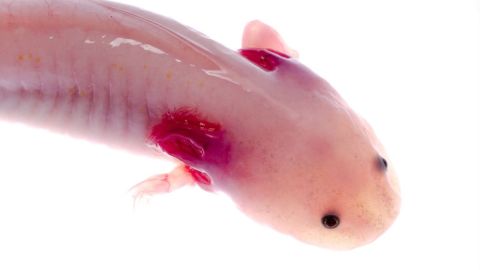How to Regrow a Limb

What’s the Big Idea?
The loss of a human limb is a tragedy. We know that once they’re gone, mammalian arms and legs can’t ever be restored. But if you cut off a salamander’s leg – or tail – it will reappear in just a few weeks. The enigma of amphibian organ regeneration has puzzled scientists since it was first recorded by Aristotle, reaching its strangest and most scientifically-accepted heights in the 1700’s, when Voltaire decapitated a snail just to see if the head would grow back. (It did.)
Now, a new generation of longevity-seekers hopes to apply the power of amphibians like the salamander, the axlotl, and the worm to human medicine. Sonia Arrison, policy analyst and author of 100 Plus, believes that tissue engineering will revolutionize the treatment of chronic illnesses: “In the future, if we had the ability to grow a brand new heart or parts of hearts with that person’s very own adult stem cells, then when we know that they have heart disease, we could just replace the heart. All of those [costly] visits to the hospital, all of the drugs, won’t be required.” Better tools will enable us to repair people rather than just sort of patching them up for a little while until they get sicker and sicker, she says.
What’s the Significance?
This idea is more practical than it sounds. Over the past few decades, scientists have begun to understand exactly how the regeneration process works in nature. When a salamander is injured, a clump of cells called a blastomea forms at the site of the wound. Like embryonic stem cells, the blastomea are especially plastic. These cells are then triggered to de-differentiate and re-initiate growth. (Debate remains over whether they’re fully pluripotent, meaning that they have the ability to form any type of tissue, or whether the cellular dynamics merely have to be reprogrammed, as in recent studies by Doug Melton of the Harvard Stem Cell Institute.)
The trick, of course, is applying this knowledge to human anatomy. Arrison explains, “Since we all evolve from the same place, humans must have a set of genes that can allow for growing back new limbs – it’s just that they’re ‘turned off’ right now.” If we could figure out how to turn them back on, or to add new genes based on the salamander model, then it could be possible to create new organs from scratch. In fact, one of the biggest spenders in this story is the Pentagon, which has put at least $250 million in to the search to find a way to create new human organs in the lab.
“They’re funding work in terms of growing all sort of organs – bladders and windpipes and hearts and lungs, livers,” says Arrison, “but also in hopes of figuring out how to regrow arms and legs” for soldiers wounded in combat. Thanks to this influx of public money, the field has moved forward much quicker than it would have otherwise. So far, researchers have succeeded growing hearts, livers, breast tissue, and bone in the lab. The brain remains elusive – but Arrison is optimistic: “The brain is much tougher than other organs in the human body, but work is moving along.”
There are, however, two things that she’s worried about. The first is that technology won’t move quick enough for those alive today. “We’ve made a lot of progress in terms of reverse engineering the human code, we’ve made a lot of progress in tissue engineering and gene therapy, but it’s that we still have a ways to go.” she says. The second is that, if we do see organ regeneration applied to medicine, the distribution of benefits like faster healing and increased longevity will be inequitable:
How long will the gap be between the wealthy getting it and the poor getting it? Because we’re already starting from a point of inequality. If you look around the world, life expectancy in Monaco in the South of France is around 90 years. Life expectancy in Angola is around 38 years. That’s like a 50-plus gap of an entire lifetime, really. And then within the United States, there’s a pretty decent gap as well. An Asian-American woman living in New Jersey has a life expectancy of around 91 years. A Native-American man living in South Dakota has a life expectancy of about 58 years.
There’s already a fifty year difference in what it’s like to be rich and poor in the world, which may or may not be alleviated by technology, she says, depending on how we choose to use it.
Image courtesy of Shutterstock.





